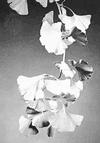- ginkgo
-
/ging"koh, jing"-/, n., pl. ginkgoes.a large shade tree, Ginkgo biloba, native to China, having fan-shaped leaves and fleshy seeds with edible kernels: the sole surviving species of the gymnosperm family Ginkgoaceae, which thrived in the Jurassic Period, and existing almost exclusively in cultivation.[1765-75; < NL representation of Japn ginkyo, equiv. to gin silver ( < Chin) + kyo apricot ( < Chin)]
* * *
Tree (Ginkgo biloba, family Ginkgoaceae) that is the only living representative of the gymnosperm order Ginkgoales.Native to China, it is often termed a living fossil because it is unclear whether uncultivated groups can be found in the wild. It has been planted since ancient times in Chinese and Japanese temple gardens and is now valued in many parts of the world as an attractive, fungus-and insect-resistant ornamental tree. It tolerates cold weather and, unlike most gymnosperms, can survive the adverse atmospheric conditions of urban areas. Pyramidal in shape, it has a columnar, sparingly branched trunk. The light-coloured wood, soft and weak, has little economic value. The fan-shaped, leathery leaves, most divided into two lobes by a central notch, resemble the leaflets of the maidenhair fern. The silvery nut, when roasted, is considered a delicacy. Studies have suggested that Ginkgo biloba supplements can enhance memory function in the elderly and delay the onset of Alzheimer disease. Ginkgo (Ginkgo biloba)Grant Heilman
Ginkgo (Ginkgo biloba)Grant Heilman* * *
▪ plant(Ginkgo biloba), tree that is the only living representative of the order Ginkgoales (division Ginkgophyta). This order included a group of gymnosperms composed of the family Ginkgoaceae, which comprised approximately 15 genera that date from the Permian Period (about 300 to 250 million years ago) of the Paleozoic Era (about 360 to 250 million years ago). Extinct genera, such as Ginkgoites and Baiera, are known from fossilized leaves that are similar to those of the present-day tree. The ginkgo, native to China, is often termed a living fossil because it was once unclear whether uncultivated groups of ginkgo could be found in the wild. It has been planted since ancient times in Chinese and Japanese temple gardens and is now valued in many parts of the world as an attractive, fungus- and insect-resistant ornamental tree. It tolerates cold weather and, unlike most gymnosperms, can survive the adverse atmospheric conditions of urban areas.A ginkgo tree is pyramidal in shape, with a columnar, sparingly branched trunk up to 30 metres (100 feet) tall and 2.5 metres (8 feet) in diameter. The fissured bark is grayish, deeply furrowed on older trees and has a corky texture. The light-coloured wood, soft and weak, has little economic value. Fan-shaped ginkgo leaves resemble the leaflets of the maidenhair fern and are borne on short, spurlike but greatly thickened shoots. The leathery leaves are up to 8 cm (3 inches) long and are sometimes twice as broad. Two parallel veins enter each blade from the point of attachment of the long leafstalk and fork repeatedly toward the leaf edges. Most leaves are divided into two lobes by a central notch. Dull gray-green to yellow-green in summer, they turn golden yellow in autumn, remaining on the tree until late in the season, and then fall rapidly.Microsporangia (pollen-forming structures) and female ovules are borne on separate trees. Pollen grains are carried to the female trees by the wind.Megasporangiate trees bear paired ovules, which, when fertilized, develop into yellowish, plumlike seeds about 2.5 cm (1 inch) long, consisting of a large inner nutlike portion surrounded by a fleshy outer covering. The “nut” is silvery in colour (the word ginkgo is derived from the Chinese and Japanese words for silver nut or silver apricot) and when roasted is considered a delicacy. The ripened fleshy covering has a very disagreeable odour, similar to that of rancid butter, making the female tree less popular for garden planting.Several varieties are available for landscape use, including columnar types and others favoured for finer growth habit, better fall colour, and other desired qualities.Ginkgo has been much used in traditional Chinese medicine. Toward the end of the 20th century, ginkgo extract became popular in many countries for its purported memory-enhancing properties, and the chemical constituents of the plant are under investigation as a possible treatment for Alzheimer disease.* * *
Universalium. 2010.
